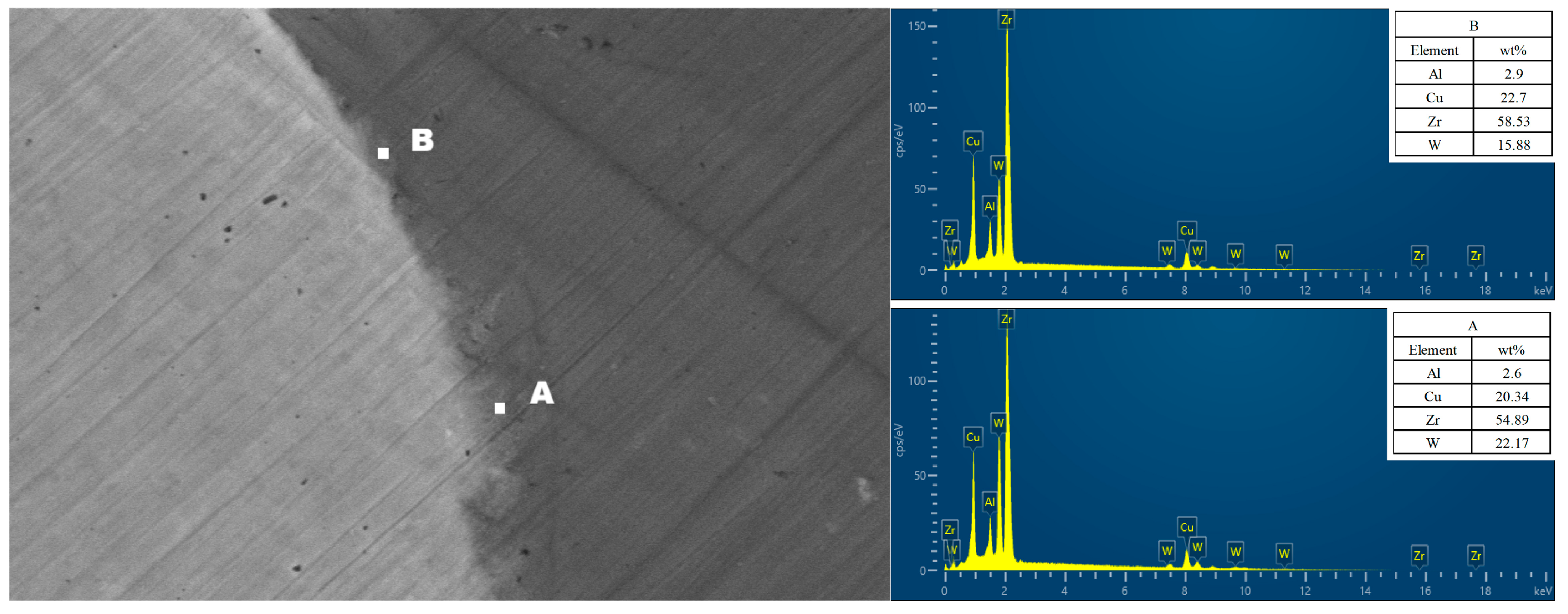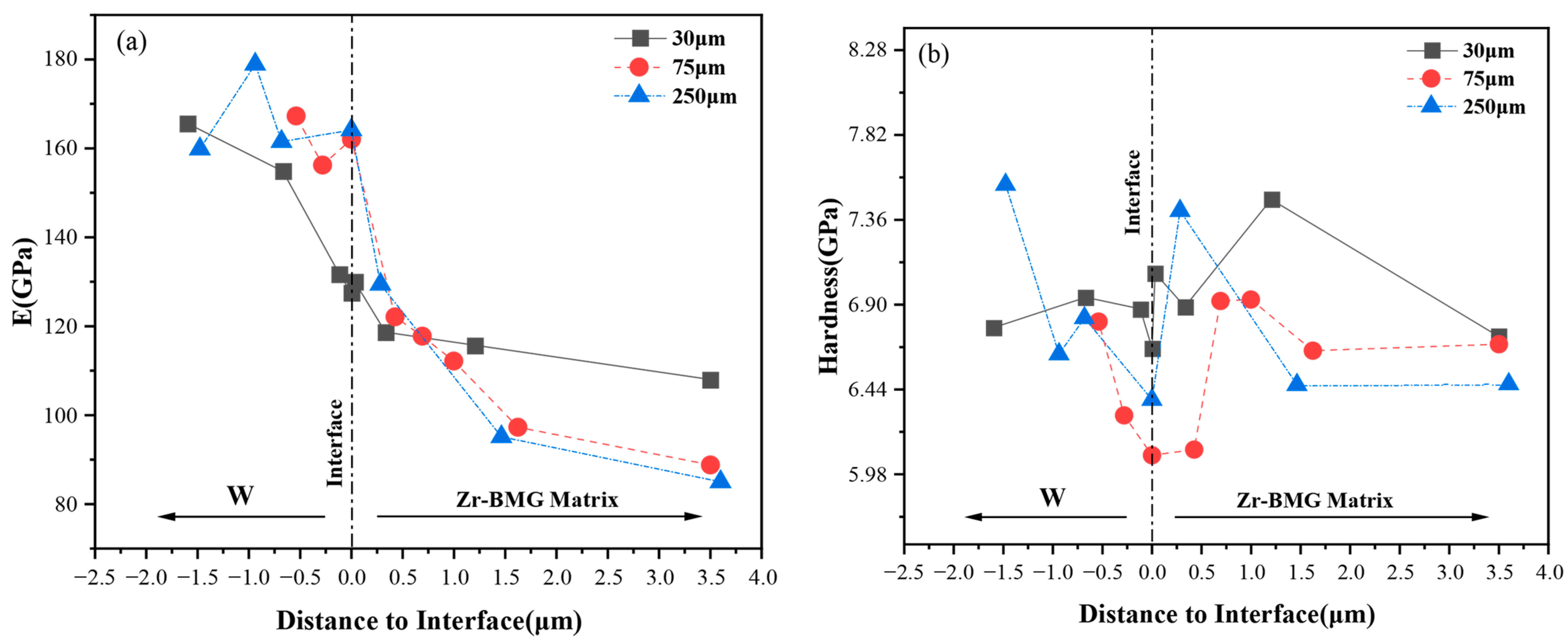Interface Characteristics of Tungsten-Particle-Reinforced Zr-Based Bulk-Metallic-Glass Composites with Different Tungsten Particle Sizes
Abstract
:1. Introduction
2. Experiment
3. Results and Discussion
3.1. Phase Analysis of Wp/Zr-BMGs with Different Wp Sizes
3.2. Interface Structure of Wp/Zr-BMGs with Different Wp Sizes
3.3. Interfacial Mechanical Properties of Wp/Zr-BMGs with Different Wp Sizes
3.4. Macromechanical Properties of Wp/Zr-BMGs with Different Wp Sizes
4. Conclusions
- The interface between Wp and Zr-BMG in Wp/Zr-BMGs with different Wp sizes exhibited a dissolution-diffusion interface without any apparent precipitated intermetallic compounds. This suggests that Wp particles have an ideal combination with Zr-BMGs after the SPS process.
- The thickness of the diffusion layer at the interface increased as the Wp particle size increased. This positively correlated size effect can be attributed to the improved wettability between Wp and Zr-BMG. Larger Wp particles had better wetting contact and resulted in a thicker diffusion layer at the interface.
- The incorporation of Wp particles not only enhanced the elastic modulus and hardness of the amorphous matrix near the interface but also improved macromechanical properties such as strength, plasticity, and elastic modulus. Notably, smaller-sized Wp particles demonstrated a more pronounced improvement in the mechanical properties of the Zr-BMG compared with larger-sized Wp particles.
Author Contributions
Funding
Institutional Review Board Statement
Informed Consent Statement
Data Availability Statement
Conflicts of Interest
References
- Wang, X.; Wu, S.; Qu, R.; Zhang, Z. Shear Band Evolution under Cyclic Loading and Fatigue Property in Metallic Glasses: A Brief Review. Materials 2021, 14, 3595. [Google Scholar] [CrossRef] [PubMed]
- Shang, B.-S.; Wang, W.-H.; Guan, P.-F. Cycle Deformation Enabled Controllable Mechanical Polarity of Bulk Metallic Glasses. Acta Mater. 2022, 225, 117557. [Google Scholar] [CrossRef]
- Thurnheer, P.; Maaß, R.; Laws, K.J.; Pogatscher, S.; Löffler, J.F. Dynamic Properties of Major Shear Bands in Zr–Cu–Al Bulk Metallic Glasses. Acta Mater. 2015, 96, 428–436. [Google Scholar] [CrossRef]
- Halim, Q.; Mohamed, N.A.N.; Rejab, M.R.M.; Naim, W.N.W.A.; Ma, Q. Metallic Glass Properties, Processing Method and Development Perspective: A Review. Int. J. Adv. Manuf. Technol. 2021, 112, 1231–1258. [Google Scholar] [CrossRef]
- Sharma, A.; Zadorozhnyy, V. Review of the Recent Development in Metallic Glass and Its Composites. Metals 2021, 11, 1933. [Google Scholar] [CrossRef]
- Zhang, M.; Huang, T.; Zhang, J.; Deng, L.; Gong, P.; Wang, X. Influence of Oxidation on Structure, Performance, and Application of Metallic Glasses. Adv. Mater. 2022, 34, 2110365. [Google Scholar] [CrossRef]
- Yang, S.; Zhang, C.; Cui, K.; Zhang, B.; Liao, S. Glass Forming Ability of Zr–(Ni, Cu) Based Ternary Metallic Glasses Based on Bond Parameter Function and Formation Enthalpy Model. Mater. Trans. 2022, 63, 676–683. [Google Scholar] [CrossRef]
- Han, J.; Jeong, U.; Lee, Y.; Marimuthu, K.P.; Lee, H. Determination of Parameters of Free Volume Model for Zr-Based BMG via Nanoindentation. Intermetallics 2021, 131, 107121. [Google Scholar] [CrossRef]
- Long, Z.; Tao, P.; Kong, L.; Wang, G.; Huang, S.; Wen, S.; He, H.; Huang, Z.; Zhu, X.; Xu, X.; et al. Effect of Cryogenic Thermal Cycling on the Microstructure and Mechanical Properties of Zr-Based Bulk Metallic Glasses. Mater. Sci. Eng. A 2023, 863, 144513. [Google Scholar] [CrossRef]
- Ma, Y.; Tang, X.; Wang, X.; Zhang, M.; Hu, H.; Gong, P.; Wang, X. Preparation and Mechanical Properties of Tungsten-Particle-Reinforced Zr-Based Bulk-Metallic-Glass Composites. Mater. Sci. Eng. A 2021, 815, 141312. [Google Scholar] [CrossRef]
- Liu, B.-C.; Zhang, Q.-D.; Wang, H.-J.; Li, X.-Y.; Zu, F.-Q. Significantly Improved Plasticity of Bulk Metallic Glasses by Introducing Quasicrystal within High Energy Glass Matrix. Intermetallics 2019, 111, 106504. [Google Scholar] [CrossRef]
- Tercini, M.; Gomes De Aguiar Veiga, R.; Zúñiga, A. Structural Changes and Kinetics of Shear Banding in Metallic Glass Composites. J. Alloys Compd. 2020, 819, 153046. [Google Scholar] [CrossRef]
- Chen, C.S.; Li, J.S.; Ma, W.F.; Kou, H.C.; Hu, R.; Zhou, L.; Fu, H.Z. Interfacial Characteristics and Mechanical Properties of W Fiber Reinforced ZrTiCuNiBe Amorphous Matrix Composite. Rare Met. Mater. Eng. 2007, 36, 1390–1393. [Google Scholar]
- Ma, G.F.; Ye, H.; Zhang, H.L.; He, C.L.; Sun, L.N.; Zhang, H.F.; Hu, Z.Q. The Relation between Wetting and Interfacial Chemistry in the Zr-Based BMGs/W System. J. Alloys Compd. 2017, 690, 903–908. [Google Scholar] [CrossRef]
- Choi-Yim, H.; Conner, R.D.; Szuecs, F.; Johnson, W.L. Quasistatic and Dynamic Deformation of Tungsten Reinforced Zr57Nb5Al10Cu15.4Ni12.6 Bulk Metallic Glass Matrix Composites. Scr. Mater. 2001, 45, 1039–1045. [Google Scholar] [CrossRef]
- Chen, X.W.; Wei, L.M.; Li, J.C. Experimental Research on the Long Rod Penetration of Tungsten-Fiber/Zr-Based Metallic Glass Matrix Composite into Q235 Steel Target. Int. J. Impact Eng. 2015, 79, 102–116. [Google Scholar] [CrossRef]
- Vishwanadh, B.; Tewari, R. Effect of Microstructure on the Mechanical Properties of Be-Free Zr-Based Bulk Metallic Glasses (BMG) and Tungsten Fiber Reinforced Metallic Glass Matrix Composites. Trans. Indian Inst. Met. 2022, 75, 997–1005. [Google Scholar] [CrossRef]
- Du, C.; Zhou, F.; Gao, G.; Du, Z.; Fu, H.; Zhu, Z.; Cheng, C. Penetration Fracture Mechanism of Tungsten-Fiber-Reinforced Zr-Based Bulk Metallic Glasses Matrix Composite under High-Velocity Impact. Materials 2022, 16, 40. [Google Scholar] [CrossRef]
- Zhang, G.D. Interfaces in Metal Matrix Composites. Chin. J. Mater. Res. 1997, 11, 649–657. [Google Scholar]
- Sun, L.L.; Wang, J.; Kou, H.C.; Tang, B.; Li, J.S.; Zhang, P.X. Interface Characteristics of a Zr-Based BMG/Copper Laminated Composite: Interface Characteristics of A Zr-Based BMG/Copper Laminated Composite. Surf. Interface Anal. 2014, 46, 61–64. [Google Scholar] [CrossRef]
- Liu, Y.; Blandin, J.J.; Kapelski, G.; Suéry, M.; Yang, X.J. Interface Characterization and Mechanical Properties of BMG/Cu Composites Prepared by Coextrusion. Intermetallics 2012, 30, 57–64. [Google Scholar] [CrossRef]
- Wang, Y.S.; Hao, G.J.; Zhang, Y.; Lin, J.P.; Song, L.; Qiao, J.W. The Role of the Interface in a Ti-Based Metallic Glass Matrix Composite with in Situ Dendrite Reinforcement: Role of the Interface in a Ti-Based Metallic Glass Matrix Composite. Surf. Interface Anal. 2014, 46, 293–296. [Google Scholar] [CrossRef]
- Hongchao, K.; Heng, G.; Jun, W.; Bin, T.; Jinshan, L. Diffusion Bonding between Zr-Based Metallic Glass and Copper. Rare Met. Mater. Eng. 2016, 45, 42–45. [Google Scholar] [CrossRef] [Green Version]
- Georgarakis, K.; Dudina, D.V.; Kvashnin, V.I. Metallic Glass-Reinforced Metal Matrix Composites: Design, Interfaces and Properties. Materials 2022, 15, 8278. [Google Scholar] [CrossRef]
- Mofid, M.A.; Jafarzadegan, M. Interface Characterization in Tungsten Fiber/Zr-Based Bulk Metallic Glass Matrix Composite. J. Met. Mater. Min. 2021, 31. [Google Scholar] [CrossRef]
- Feng, Z.B. Preparation and Properties of Tungsten Fibers/Particles Reinforced Zr-Based Amorphous Composite Materials. Master’s Thesis, Shenyang University of Technology, Shenyang, China, 2020. [Google Scholar]
- Oliver, W.C.; Pharr, G.M. An Improved Technique for Determining Hardness and Elastic Modulus Using Load and Displacement Sensing Indentation Experiments. J. Mater. Res. 1992, 7, 1564–1583. [Google Scholar] [CrossRef]
- Doerner, M.F. A Method for Interpreting the Data from Depth-Sensing Indentation Inst Rurnen Ts. J. Mater. Res. 1986, 1, 601–609. [Google Scholar] [CrossRef]
- Beygi, R.; Galvão, I.; Akhavan-Safar, A.; Pouraliakbar, H.; Fallah, V.; Da Silva, L.F.M. Effect of Alloying Elements on Intermetallic Formation during Friction Stir Welding of Dissimilar Metals: A Critical Review on Aluminum/Steel. Metals 2023, 13, 768. [Google Scholar] [CrossRef]
- Yi, X.S.; Du, S.Y.; Zhang, L.T. China Materials Engineering Canon: Composite Endineering; Chemical Industry Press: Beijing, China, 2006. [Google Scholar]
- Conner, R.D.; Dandliker, R.B.; Scruggs, V.; Johnson, W.L. Dynamic Deformation Behavior of Tungsten-fiber/Metallic-glass Matrix Composites. Int. J. Impact Eng. 2000, 10, 435–444. [Google Scholar] [CrossRef]
- Kirchberg, S.; Abdin, Y.; Ziegmann, G. Influence of Particle Shape and Size on the Wetting Behavior of Soft Magnetic Micropowders. Powder Technol. 2011, 207, 311–317. [Google Scholar] [CrossRef]










Disclaimer/Publisher’s Note: The statements, opinions and data contained in all publications are solely those of the individual author(s) and contributor(s) and not of MDPI and/or the editor(s). MDPI and/or the editor(s) disclaim responsibility for any injury to people or property resulting from any ideas, methods, instructions or products referred to in the content. |
© 2023 by the authors. Licensee MDPI, Basel, Switzerland. This article is an open access article distributed under the terms and conditions of the Creative Commons Attribution (CC BY) license (https://creativecommons.org/licenses/by/4.0/).
Share and Cite
Jin, H.; Hu, H.; Chi, J.; Ma, Y.; Su, X. Interface Characteristics of Tungsten-Particle-Reinforced Zr-Based Bulk-Metallic-Glass Composites with Different Tungsten Particle Sizes. Materials 2023, 16, 5212. https://doi.org/10.3390/ma16155212
Jin H, Hu H, Chi J, Ma Y, Su X. Interface Characteristics of Tungsten-Particle-Reinforced Zr-Based Bulk-Metallic-Glass Composites with Different Tungsten Particle Sizes. Materials. 2023; 16(15):5212. https://doi.org/10.3390/ma16155212
Chicago/Turabian StyleJin, Haoyu, Huie Hu, Junhan Chi, Yunfei Ma, and Xiaohong Su. 2023. "Interface Characteristics of Tungsten-Particle-Reinforced Zr-Based Bulk-Metallic-Glass Composites with Different Tungsten Particle Sizes" Materials 16, no. 15: 5212. https://doi.org/10.3390/ma16155212




